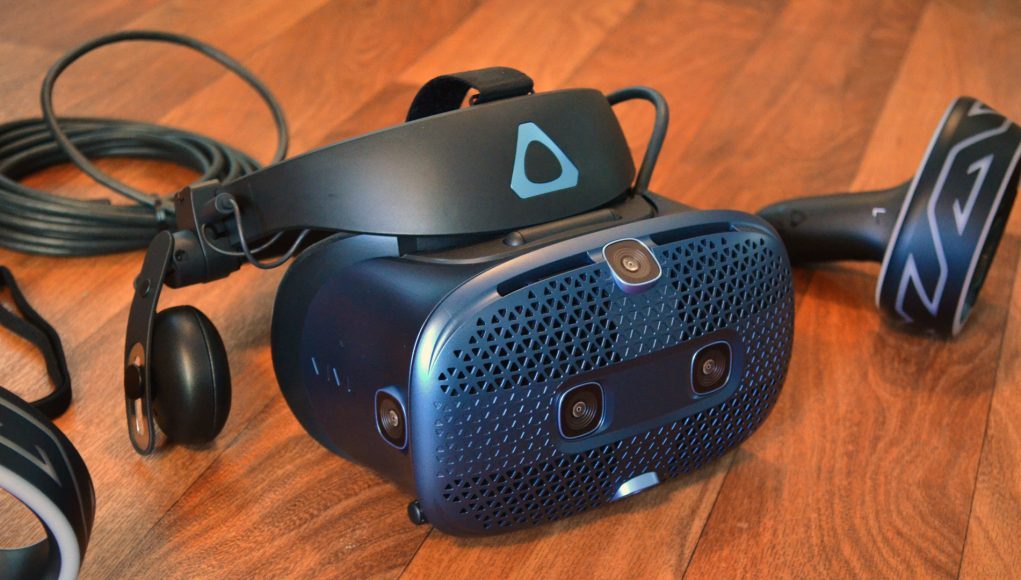Vive Cosmos has arrived and takes HTC’s consumer headset ambitions in a somewhat different direction. Three and a half years after the launch of the original Vive, Cosmos finds itself in a rather strange competitive landscape where it simultaneously must defend itself from a longstanding rival on the low-end and its former ally on the high-end. Read on to find out how it fares.
Before we start, you may recall that we initially postponed our review as we were waiting to hear back from HTC on an issue regarding the headset’s light sensitivity. The outcome of that inquiry is addressed below.
Vive Cosmos Review
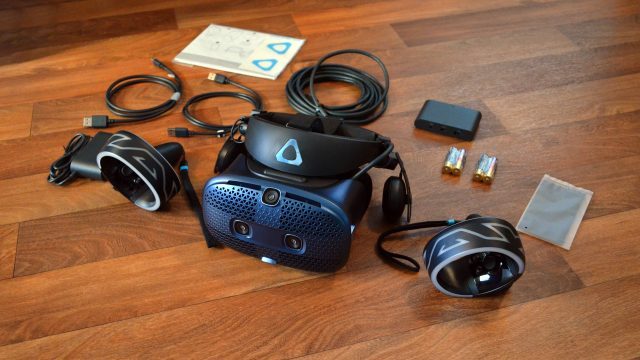
While the original Vive was a collaboration between Valve and HTC, which resulted in the headset being deeply tied to both Steam and the SteamVR Tracking system (AKA Lighthouse), Cosmos shows several ways in which HTC is hoping to divest its VR business from Valve and create its own distinct offering. Unfortunately, vestiges of what once was manifest now cause complications for Cosmos.
In terms of pricing, at $700, Cosmos fits between two primary competitors: Rift S on the low-end at $400 and Index on the high-end at $1,000 (or $750 for anyone who already owns SteamVR Tracking base stations). In order for Cosmos to succeed in this middle ground, it ideally needs to do most things better than Rift S, even if it can’t quite match the more expensive Index.
Starting with the hardware design, Cosmos doesn’t do much to justify its $700 price tag. While the industrial design is fine—if uninspired—there are several elements which make Cosmos feel a bit cheap. The seemingly tacked-on headphones with exposed wires doesn’t jibe with the flimsy headband. The removable face gasket (to which the face-foam attaches) genuinely feels like it’s about to break every time it’s removed. The forehead-rest (which you must remove if you want to take off the headphones) also feels like it wants to break upon removal and is a frustrating challenge to put back in place due to 13 individual plastic clasps across a complex curved surface which holds it in place.
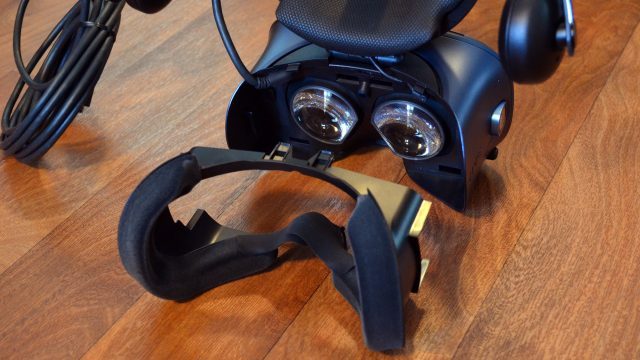
On that note though, Cosmos takes after the Vive Pro with the best nose-cavity light blocker of any headset in the industry, and the facial interface offers a full enclosure that blocks out all light. Cosmos also has a flip-up visor which is a very welcomed addition that saves you from needing to completely remove and then refit the headset if you need to peer into the real world just for a moment or two.
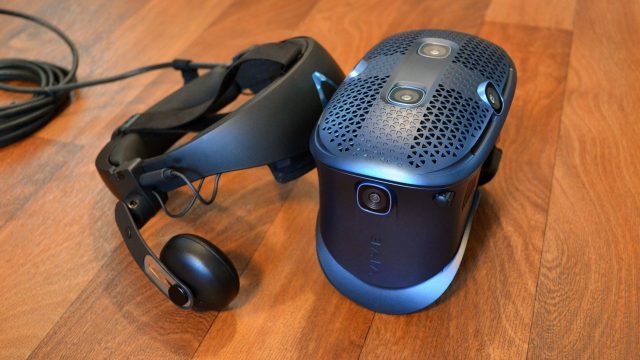
Unfortunately Cosmos’ halo-style head-mount seems to offer two mutually exclusive choices: comfort or clarity. With such a small sweet spot on Cosmos, getting your eyes into the ideal position is critical for the best visual clarity. At least for me, that ideal eye position is not the ideal comfort position, and after 30 minutes or so in the headset, the pressure on my forehead is very apparent. Unfortunately, moving the headset into its most comfortable position means my eyes are poorly aligned with the sweet spot of the lens and I get a notably reduced visual experience.
And while Rift S shares the same ‘comfort or clarity’ problem with regards to ergonomics, Cosmos’ weight and front-heavy design amplify the issue even more. I actually felt some pain in my back between my shoulders after a one and a half hour session with Cosmos, something I don’t recall experiencing with other headsets. Needless to say, if your head doesn’t agree with halo-style head-mounts, it probably isn’t going to agree with Cosmos.
While Cosmos struggles in the build quality and ergonomics department, one place where it does fare pretty well is in visuals. HTC quotes the headset’s field of view at the same 110 degrees diagonal as the original Vive and Vive Pro (which feels about right) and going side-by-side with the Rift S shows Cosmos as the obvious winner in FOV, though Index ultimately takes the cake over both.
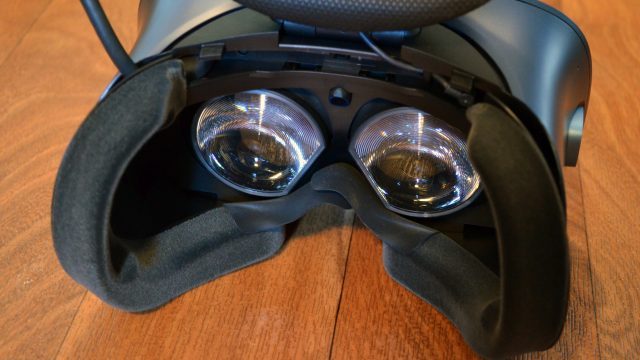
The headset’s slightly higher per-eye resolution compared to Index and somewhat smaller FOV reflect what the on-paper specs would suggest: 1,440 × 1,700 per-eye at a somewhat smaller FOV than Index’s 1,440 × 1,600 resolution results in a bit more pixel density and a slight edge in reduced screen door effect for Cosmos. Ultimately Cosmos, Index, and Rift S are all in effectively the same class when it comes to pixel density and screen-door effect.
Unfortunately, like all HTC headsets before it, Cosmos’ lenses have a frustratingly small sweet spot (the area of maximum visual clarity). If your eyes aren’t in perfect alignment with the lenses (or if you roll your eyes to look around the field of view without turning your head) you’re going to see uncomfortable blurring in the periphery. This makes Cosmos’ ergonomic prognosis even more severe—if the ideal alignment of your eyes to the lenses doesn’t also result in a comfortable fit, you’re going to have trouble maintaining comfort for longer sessions.
When it comes to glare and god rays, Cosmos’ Fresnel lenses look to have somewhat reduced god rays and glare compared to Vive and Vive Pro, similar in extent to Rift S. Meanwhile, Index’s dual-element optics have similar god rays but lots of glare. As ever, god rays and glare really only stand out in high-contrast visuals.
While the difference isn’t quite large enough that I’d personally be able to guess which is which, the 90Hz displays on Cosmos give a bit of added smoothness to motion compared to the Rift S at 80Hz. However, Index at 120Hz (or even 144Hz if your PC has the horsepower) is a noticeable step up.
Cosmos’ on-board headphones sound good, though the spring-flip design made me appreciate the off-ear audio solutions of Rift S and Index. Unfortunately the spring-flip design can be obnoxious at times because the flimsy Cosmos headband will sometimes flex instead of the headphone flipping into place as it should, which means needing to grab the headphone by its strut and to force it into position when it should have just flipped into place on its own.
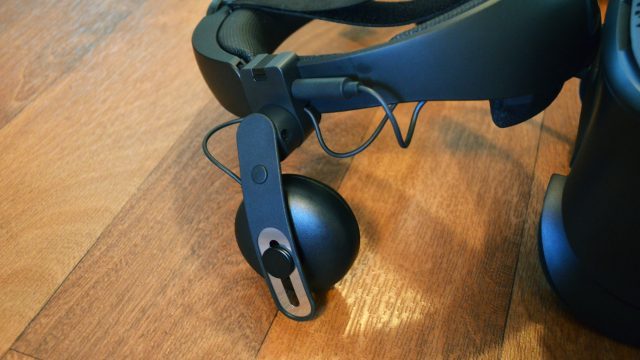
Luckily if you want to use your own headphones to remedy this issue, you can remove Cosmos’ headphones without tools and then plug in your own via the 3.5mm headphone jack (though earbuds tend to work best because it’s hard to find banded headphones which play well with a halo head-mount on a VR headset).
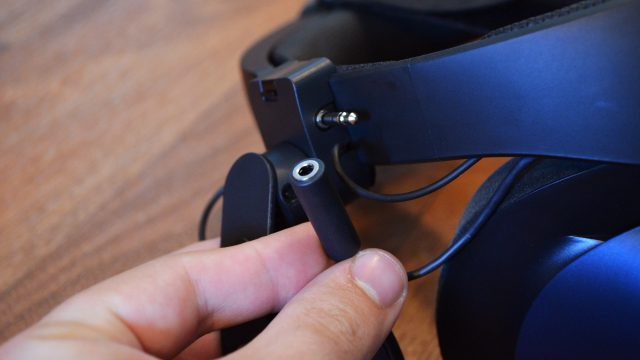
Then we come to tracking. The stock Cosmos moves away from SteamVR Tracking—the gold standard for room-scale tracking—and to its own inside-out tracking system which uses six cameras on the headset to track the position of both the headset and its controllers. While SteamVR Tracking requires external beacons which can be cumbersome to set up, Cosmos’ inside-out tracking is fully self-contained and brings a much easier plug and play experience. Unfortunately this comes at the cost of tracking precision and accuracy.
And while Rift S’ inside-out tracking system holds up quite well against SteamVR Tracking outside of some specific cases, Cosmos struggles to reach the same level of precision unless you’re in a very well-lit room.
You may have seen that we initially postponed our review of Cosmos because the headset was so aggressively complaining of bad lighting that we thought it might be defective. Initially we couldn’t get Cosmos to function at all after the Sun had set, even when every other inside-out tracked headset we have on hand worked without problem. After we reached out to understand the scope of the problem, HTC pushed out a patch which made the headset more accepting of low-light situations.
And while the initial setting was surely too aggressive, anything but a very well-lit room results in reduced precision which causes the headset to jitter more than desired. These small movements (which represent the limit of the headset’s tracking precision) aren’t outright disruptive to the experience, but they can lead to subtle discomfort.
At least in the nominal lighting condition in my playspace (no overhead lighting), Cosmos’ tracking performance falls somewhere between PSVR and Rift S (leaning closer to Rift S). This is still ‘good enough’ for a broad range of cases, though you probably would get frustrated if trying to do precision work with Cosmos like VR painting, sculpting, or designing, unless you’re in a room that’s perfectly lit to the headset’s specification. HTC doesn’t offer any specific guidance on how bright your space should be for Cosmos.
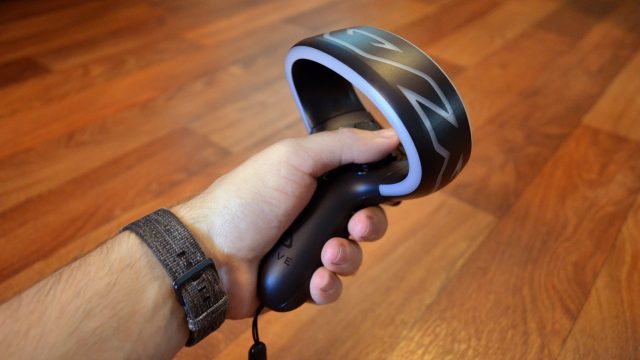
Cosmos’ controllers are a big shift for HTC which has relied on its original Vive wands for years. The Cosmos controllers come more in line with the rest of the industry now with thumbsticks, two primary face buttons, an index trigger, and a grip trigger, though it also adds a ‘bumper’ above the index trigger.
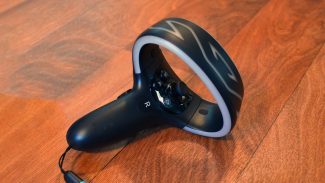
The Cosmos controllers, which rely on two AA batteries, are decidedly chunky and do not have a very favorable center of gravity, giving them a worse-in-class feel compared to Oculus Touch and Index controllers, though they are still preferred over the original wands.
The controllers track relatively well (though they are equally impacted by the precision issues discussed above) and the six camera tracking coverage feels comparable to Rift S and a clear step up over the two-camera tracking system used on Windows VR headsets. While they seem to have a bit of added latency compared to Rift S controllers, it’s not too much to be easily compensated for; I was able to play Beat Saber on Expert+ with no complaints.
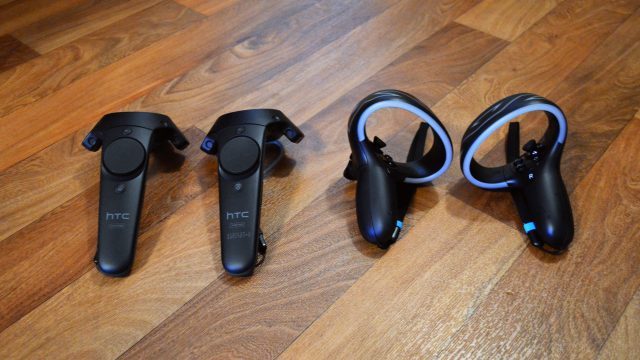
The controller tracking has some expected dead-spots very close to the headset but handles them gracefully by freezing the controller in place until it is reacquired. I was able to play games like The Lab’s ‘Longbow’ without issue for the most part, even as I was pulling the bowstring right up to my cheek before releasing the arrow. Depending upon the specific game, this could prove problematic at times if you will have your controllers very close to your headset for extended periods and still need to control them with fine motions, but this is typical for any inside-out tracking system.
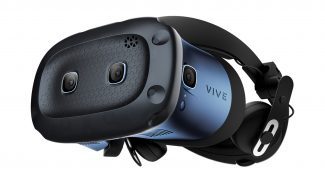
HTC has announced plans to release a swappable faceplate add-on for Cosmos in early 2020 which will imbue it with SteamVR Tracking capabilities. We haven’t had a chance to test this yet, though it’s expected to cost around $200 and will require separate controllers.
Cosmos will also be compatible with the Vive Wireless Adapter via an additional $50 add-on which is expected to ship later this month. We also haven’t had a chance to test this with the headset.
On the software and experience side, HTC is attempting to build out its own ecosystem and simplify the end-user experience with both Viveport and the ‘Vive Reality System’. Unfortunately Cosmos is still fundamentally stuck with Valve because Cosmos is still a SteamVR headset at its core.
And while that’s a big plus for anyone who is already bought into the SteamVR ecosystem, it complicates HTC’s efforts to make Cosmos a simple and user-friendly experience.
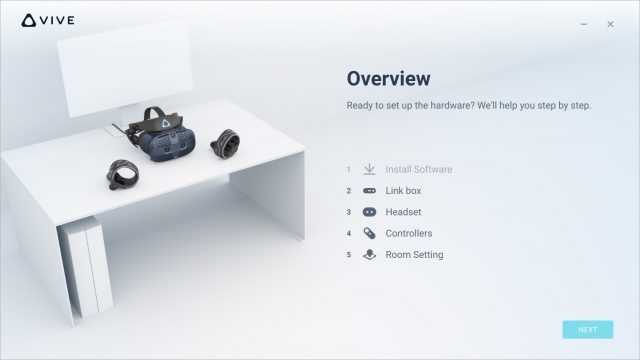
While the Vive setup software felt modern and was easy to follow, it doesn’t really explain the connection between Cosmos/Vive and SteamVR for new users at all, despite SteamVR being where a bunch of really important settings live (like audio configuration, supersampling, etc). So no matter how user-friendly the Cosmos software might be or become, it still can’t rid itself from the complexities and often fiddly nature of SteamVR.
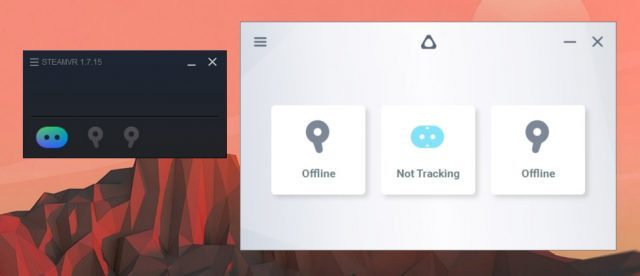
This vestigial Steam/Vive relationship gets even more confusing for new users when it comes to content. Though Steam offers up the largest and best library of game content for the headset, HTC points users straight to its Viveport VR app store. Central to Viveport is Viveport Infinity, the company’s subscription game service (which is included for a year with Cosmos) that offers up access to a bulk of the Viveport content library for a monthly subscription. And while Viveport Infinity offers a decent value thanks to encompassing some genuinely recommendable content, it prefers to dangle heaps of shovelware in front of new users rather than point them to top VR titles that are available on Steam but not on Viveport.
The Vive Reality System, which is supposed to be a top-down in-VR user experience foundation, is little more than a dashboard and a ‘home’ space in the headset at launch. ‘Lens’ is what they call the dashboard; it looks nice and makes it easy enough to scroll through your library and launch new games, but that’s just about all it does.
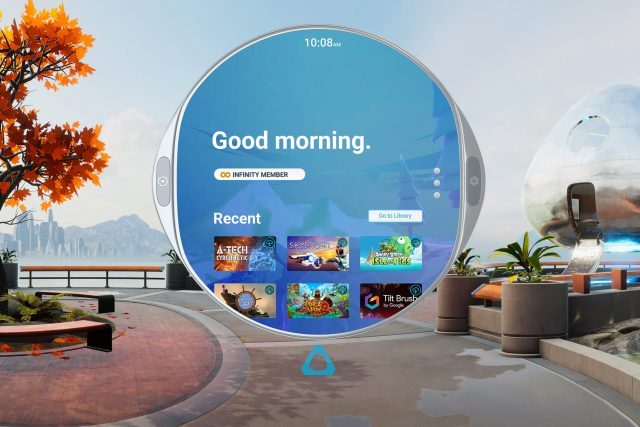 HTC had teased that Vive Reality System would include much more, like social features and social spaces, but that’s all apparently still on the horizon, leaving Steam instead to supplant key features like friend lists, social spaces, text & voice communication, and foundational multiplayer functionality.
HTC had teased that Vive Reality System would include much more, like social features and social spaces, but that’s all apparently still on the horizon, leaving Steam instead to supplant key features like friend lists, social spaces, text & voice communication, and foundational multiplayer functionality.
One place where HTC did deliver on making a straightforward improvement over SteamVR is in Cosmos’ room-scale setup. Cosmos uses a similar approach to Rift S when it comes to drawing out the playspace boundary: using the pass-through camera, you point the controller at the ground and actually trace the edge of your available playspace. This defines your ‘chaperone’ system which pops up as a grid when you get near it to prevent you from walking into anything in the real world. This approach is quick and easy and even Index hasn’t caught up just yet.
Summary
Despite its small sweet spot and occasionally iffy build quality, Vive Cosmos could be a decent headset so long as you find it comfortable. Even so, it unfortunately doesn’t feel like it lives up to its $700 price point when seen in the context of the competition.
While Cosmos scores a few points here and there (like a wider field of view and better sound), Rift S seems to offer a generally better experience for $300 less. On the other hand, while Index costs $300 more than Cosmos, it does a lot more to justify that premium price with top notch tracking, incredible audio, high build quality, better ergonomics, and overall much better optics. And if you’re an early adopter who already owns base stations (making Index just $50 more) and is weighing Cosmos vs. Index, there’s pretty much no question that you should go with Index as long as base stations aren’t a hindrance to your use of VR.
Taking everything into consideration, it’s hard to feel like Cosmos can really be competitive with either of its main contenders unless priced squarely at the Rift S’ $400 price point, but I don’t see that happening any time soon.
Disclosure: HTC provided Road to VR with a Vive Cosmos headset.

